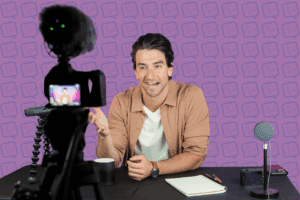Influencer Marketing as an SEO Cheat Code
Let me tell you something you already know: SEO is frigging hard.
It feels like the entire SEO game boils down to domain authority. One gets a domain of authority by having an audience. One gets an audience through content creation. Want to rank for that keyword? Create great content, get an audience, build backlinks and viola, you might rank – and it might be 2026.
As marketers, we’ve spent countless hours trying to figure out the best way to game the system to rank fast. Those that did have benefited immensely from it, but their strategies have been long rendered obsolete by Google’s algorithm updates. At the end of the day, it always comes back to creating great content and that’s just not something that can be done quickly.
Well, I think I’ve got the SEO hack for 2017. Unlike past hacks, it is grounded in great content and it will live far beyond that next update.
It’s not based in Google search, however. This tactic is all about YouTube SEO.
How is this helpful? You may be surprised.
Why YouTube SEO?
Why would I wrote a SEO article that isn’t about Google search? I believe YouTube is the one entity that could overtake Google as the dominant search engine in the world (luckily, they are on the same team). A few stats to back this up:
- Take all the search queries from Bing, add them to Ask.com, AOL and Yahoo and it still doesn’t equal the amount of queries that YouTube generates.
- In 2014, 71% of marketers said their video content’s conversion performance was either somewhat or much better compared to other types of marketing content.
- By 2019, 80% of all online content will be video.
YouTube is a already a search powerhouse, but every year more curious minds are turning to video to find information important to them. This is the time to start building a SEO strategy on the network.
How to Rank on YouTube
Like Google SEO, it isn’t easy to get videos to rank. A lot of factors go into what YouTube is looking for for videos of a certain keyword, but the main factor: great video, great channel, great engagement and proper optimization. The nine factors it takes to produce a video that is probably going to rank:
1) Targeted Keyword Research
The starting point for any SEO campaign is keyword research. What would you like to rank for?
2) Content Strategy
After identifying the list of keywords we are targeting, a content strategy is needed. Videos have to be relevant to the keyword and help solve the problem the searcher has, as well as be able to keep their attention.
3) Production
If the video isn’t produced well, it isn’t going to be watched for very long. Poorly produced videos can kill engagement rates, sinking any chance it has of ranking. Good production quality includes: proper camera, sound and lighting equipment and a decent filming location.
4) Personality
Whoever is on-camera must be able to connect with the audience. They need to be charismatic and be able to deliver their lines in a professional, informative or entertaining way.
5) Direction
Who is behind the camera? Do they know the simple techniques that make for good video? This includes angles, lighting and a variety of stylistic choices that can make a video stand out.
6) Editing
What editing software are you going to use? Do you know how to use it? Do you know what makes for good transitions, title effects, motion techniques, etc?
7) Optimization
When the video is ready to be published, be sure that the keyword is in the title, description and tags of the video. For example, if the keyword is “winter coat” then the title might be “Winter Coats for 2017,” the description might read “A look at my favorite winter coats for 2017” and the tag will simply be: “winter coat.”
8) Engaging Audience
Every like, share, comment and subscription driven by the video will boost its overall SEO value. It’s important the channel publishing the video has an existing engaging audience or has a plan to manufacture engagement.
9) Channel of Authority
It’s not absolutely necessary to rank, but if the channel publishing the video has a history of great video and engagement they are far more likely to get a video to rank faster.
Whew, exhausting, right? Steps 1 and 7 seem easy enough, but the other steps can be incredibly difficult and time-consuming to execute. Steps 8 and 9 are the most difficult and the most vital if looking to create a video right away.
Let me reiterate: SEO is friggin hard, even on YouTube.
I know a shortcut.
The Influencer Marketing Hack
Let’s take a look at the current top video ranking for “winter coats”:
Wouldn’t it be great if your channel had the power of Lydia’s channel, both in terms of quality of video, the brilliant content and her audience? That would take years to build, so what if you buy hers?
The beautiful thing about influencer marketing is that we can outsource all the difficult steps. Through partnerships with YouTube creators, you can buy their content creation and video production skills. More importantly, you can buy their pre-existing channel authority and engaging audience.
These YouTubers already have great channels, full of awesome video and highly engaged audiences – you wouldn’t be partnering with them if they didn’t. They take care of all the difficult steps, all you have to do is make sure their videos are properly optimized for the keywords you are targeting.
Depending on how competitive your keyword is, it is possible to start dominating page 1 of a YouTube search with just a few partnerships (with the right influencers).
Content Ownership
I know what you might be thinking: you won’t own any of the content. This is true, the video and channel belong to the influencer you partnered with.
This would be a non-starter if we were talking about Google, but YouTube is a different ballgame. Every YouTube user has the same initial experience: watching a video within the confines of the network itself. They don’t leave the YouTube.com domain upon initial search for a video. If they do leave, it is because the video drove them to take a specific action: usually clicking a link in the description or in an in-video annotation. You can control this action via the agreement you make with the influencer. If someone is intrigued by the message of the video, the only option they have is to be directed to your domain.
Profit??
Imagine a world where someone searches for winter coats and 6 of the top 8 videos were from YouTubers you partnered with. That is some powerful buying potential.
If you plan your campaign correctly, you could flood YouTube search results with real-time relevant videos based on a keyword you covet. Pretty cool, right?
Need help identifying influencers? We’d love to help.





